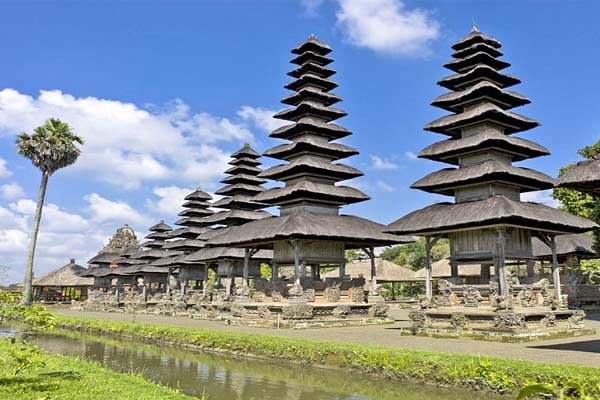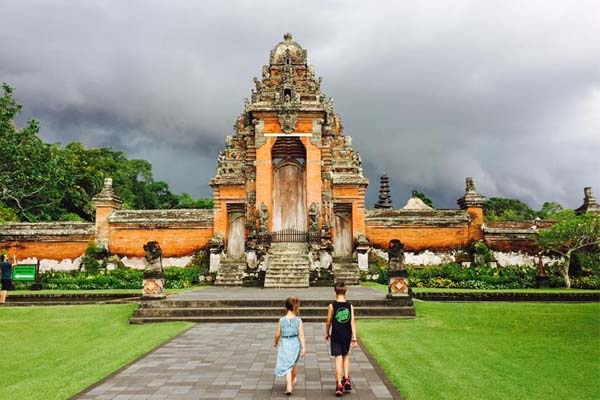In 2012, Unesco designated Taman Ayun Temple as part of a world cultural heritage site. The site is officially titled Cultural Landscape of Bali Province: Subak System as a manifestation of the Tri Hita Karana philosophy (Cultural landscape of Bali Province: The subak system as a manifestation of the Tri Hita Karana. Includes Ulun Danu Beratan Temple and Batur Lake, a watershed (DAS). ) Pakerisan, the Catur Angga Batukaru area and the Taman Ayun Temple site.
History
Taman Ayun Temple was built in the 17th century to be precise starting in 1632. And was completed in 1634 by the king of the Mengwi Kingdom, who at that time had another name for the kingdom "Mangapura", "Mangarajia", and "Kawiyapura", namely I Gusti Agung Putu Raja. Mengwi kingdom at that time.
In the construction of Taman Ayun Temple, he was assisted by an architect who came from a Chinese descent from Banyuwangi named Ing Khang Ghoew who was also often called I Kaco, a colleague of Raja Mengwi.
Taman Ayun Temple is a family temple for the Mengwi Kingdom. Initially, this temple was founded because it pretended that at that time the distance was too far for the Mengwi people to reach. Therefore, the King established a place of worship with several buildings as a symbol of 9 main temples in Bali, such as Besakih Temple, Ulundanu Temple, Batur Temple, Uluwatu Temple, Batukaru Temple, and other main temples in Bali. Bali.
Temple complex
The temple complex is divided into 4 different courtyards, one higher than the other. The first courtyard is called Jaba which can be reached only by passing the only pond bridge and gate. Once inside there is a small monument to guard the entrance and to the right of it is a large building (wantilan) where cockfights are often held during ceremonies. Onthis page, there is also a fountain monument that points to the 9 cardinal directions.
While heading to the next page, on the right side of the road there is a small temple complex with the name Pura Luhuring Purnama. Area three or page two, its position is higher than the first page. To enter this page, visitors must pass through the second gate. Once inside, the view will be fixed on an aling-aling Bale Pengubengan building decorated with reliefs depicting Dewata Nawa Sanga (9 deities guarding the cardinal directions).
To the east of this courtyard there is a small temple called Pura Dalem Bekak, while in the western corner there is a towering Kulkul Hall. The fourth area or final courtyard is the highest and the holiest. The middle door of the coil will be opened when there is a ceremony, a place where statues and other ceremonial equipment can enter.
While the gates on the left and right are for going in and out of daily activities at the temple. On this page there are several towering meru of various sizes and shapes. The three pages of this temple symbolize the three levels of world cosmology, from the lowest is the place / world of humans, to a more sacred level, namely the dwelling place of the gods, and the last one symbolizes Heaven where God Almighty belongs.
As told in the ancient story of Adhiparwa, the entire temple complex depicts Mount Mahameru floating in the middle of a sea of milk.
Henk Schulte Nordholt wrote in his book Negara Mengwi that Taman Ayun Temple was renovated in 1750. The name of the architect responsible was written as Hobin Ho. This Pura Park appeared on the television show Around the World in 80 Gardens.
Taman Ayun Temple The temple shares the same anniversary day of the cliff-perched Uluwatu Temple on the island southern Bukit peninsula, which is celebrated on the 210 day Balinese Pawukon calendar system or on every Kliwon Medangsia Tuesday. The piodalan temple anniversary celebrations see pilgrims flock to the temple complex, day and night.
Entrance Ticket Domestic : IDR 20,000
Entrance Ticket Foreigners : IDR 30,000





